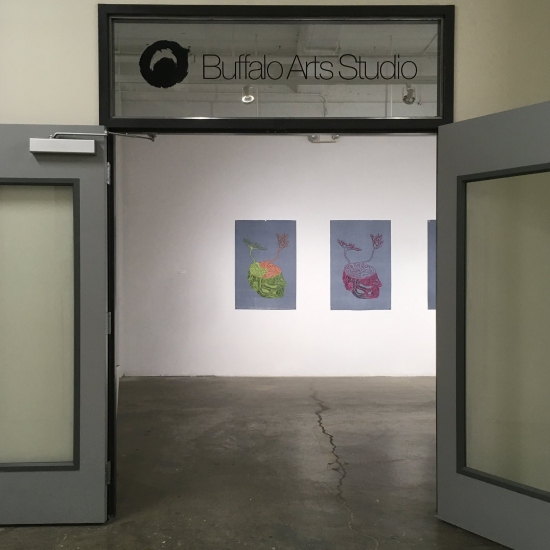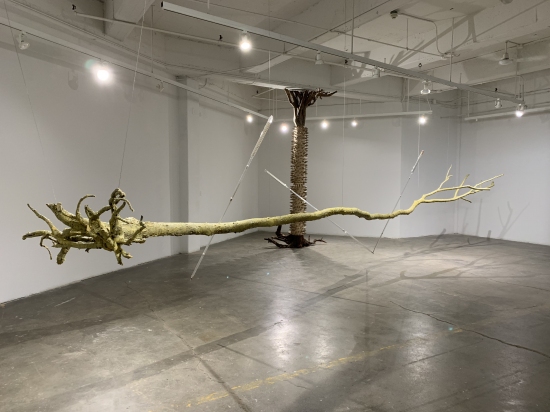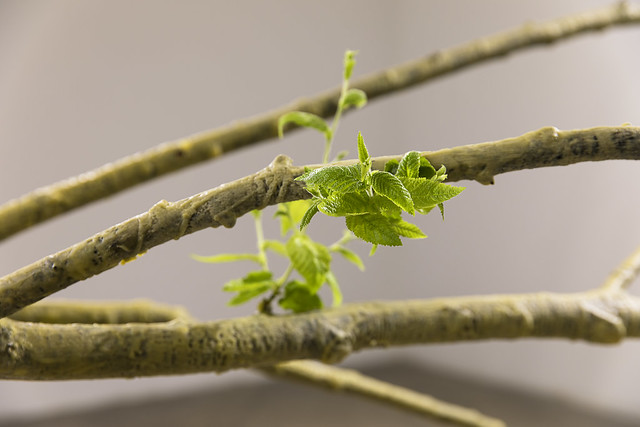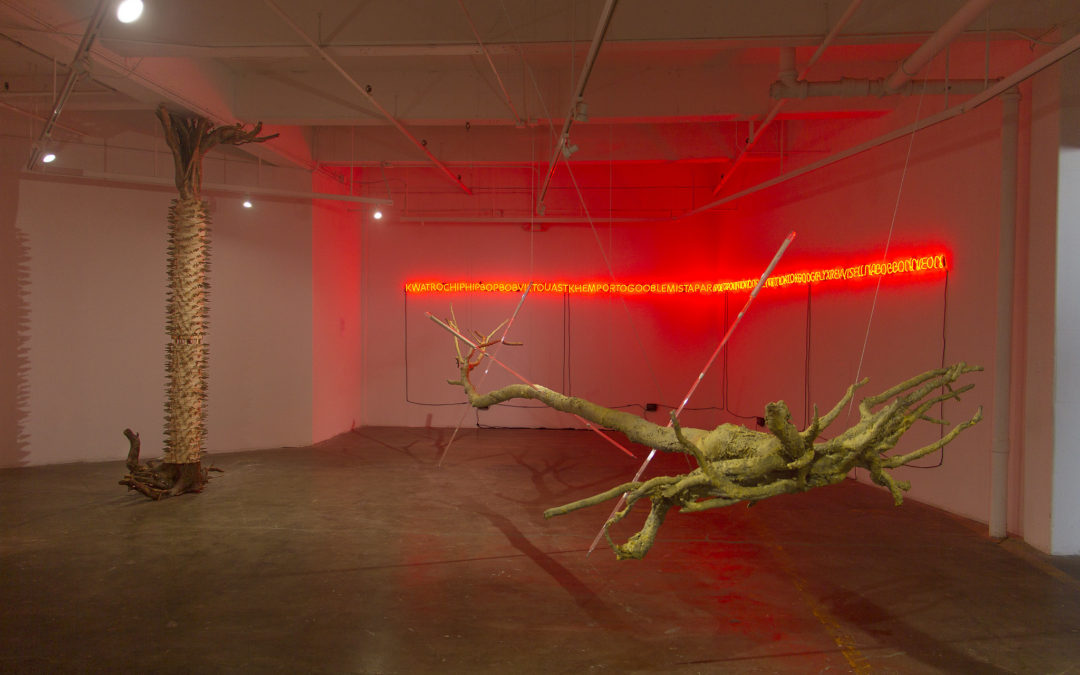Reinhard Reitzenstein’s solo exhibition, WTF (Where’s the Forest), was on view at Buffalo Arts Studio from May 24-June 28, 2019.
“What Time is it on the Clock of the World?”
Post-Exhibition Community Commentary by Harper Bishop
American revolutionary Grace Lee Boggs famously said, “What time is it on the clock of the world?”
This question is not merely a philosophical one, but one to be answered with action, which is why it has been adopted by so many within the ecological justice movement to address the global climate crisis and the solutions necessary to save the human species from extinction.
It is within that context that I received Reinhard Reitzenstein’s recent solo exhibit at Buffalo Arts Studio, WTF (Where’s the Forest). Whether consciously or subconsciously, Reitzenstein has taken Grace Lee Boggs’ question to heart. Reitzenstein’s keen observations and lengthy contemplations on the urgency for human beings to take notice of the web of life which sustains life, and life in abundance, in a technologically, development-driven age, particularly through his myriad studies of the tree in various mediums, have produced a body of work that serves as a reminder to us all that the time to reconnect to the natural world, to rediscover our own humanity, and to take bold action is not only nigh, it is now.

At the end of the long corridor on the 5th floor of the Tri-Main Building, the Buffalo Arts Studio entryway comes into view. Even before you reach the threshold of the front gallery, you see a set of three prints on oversized pieces of grey paper; a side profile of the same human being is situated in the middle of the paper. The brains and nervous systems have been replaced with tree roots, the top of which are coming out of the head, and offer a surrealist illustration of analogous systems. The bold colors become more muted with each iteration and one can’t help but feel both the fast and slow moving passage of time.

The most celebrated piece in the collection is a forty foot tree covered in yellow beeswax. “Feel the Buzz” is suspended from the ceiling of the second gallery and is the focal point of not only the space but of the show itself. Hidden in plain sight; it’s only after the viewer has interacted with various other pieces (a few of which I’ve already mentioned) in the front gallery that the proverbial elephant in the room can no longer be evaded, a fitting analogy to the current climate crisis. Conceptually, Reitzenstein’s piece “points to the complicity of the industrial past and gentrified present in the production of greenhouse gasses and eradication of green spaces necessary to counteract global warming.”
A sharp critique, Reitzenstein, rightfully, cites capital as the source of the current climate crisis and reminds us that there’s no “turning back the clock” on harm caused to our environment in the name of “progress.”
Two other pieces co-located with Reitzenstein’s tree are “Add a Little to a Little and There will Be a Big Heap” and “The 11th Thunder.” The first one conspicuously stands in the far back left-hand corner of the gallery. Another tree, the roots and crown support the plywood rings and laser cut tree symbols that are reminiscent of air fresheners that have hung in rearview mirrors for decades. This is yet another contrast in the collection between the world as it is and should be, and the world under human subjugation. The latter piece is a sprawling neon installation with a combination of letters that is seemingly random at first glance, but actually contains a very specific and personal meaning relating to the artists life. Juxtaposed with the suspended horizontal tree, it brings to mind the human need to leave an imprint and the glaring difference of what that looks like.
Through his work, Reitzenstein subtly conveys a number of social and ecological messages that relate to the contrast of extractive and exploitative activity with right relationship with the natural environment. It foregrounds particularly those on the front lines of climate catastrophe and what sacrificed in order to concentrate power and wealth for the few at a cost to the many.

So, back to the clock. What time is it? According to the introspection of Reinhard Reitzenstein and the retrospection of WTF (Where’s the Forest), it feels like it’s close to the 11th hour. And yet, to bring this full circle, Grace Lee Boggs was known for her optimistic spirit and this exhibition channeled that spirit. A dead tree hanging from the ceiling of an art gallery is an unlikely candidate for new leaves, and yet it happened: they grew.
There’s still time. Be like the majestic trees forever enshrined in Reitzenstein’s work, with deep roots that allow them to stand with resolve and determination despite adverse conditions; roots that provide nourishment to continue the fight ahead; and, finally, roots that alert others in their network of a potential threat. For all of those interested in learning more about how to create sustainable and resilient communities learn more about PUSH Buffalo’s Green Development Zone, and for those who are ready to take bold action for climate justice now, contact PUSH Buffalo’s Climate Justice Organizer Geo Hernandez at geo@pushbuffalo.org or by visiting our website at www.pushbuffalo.org.
Harper Bishop is the Deputy Director of Movement Building at PUSH Buffalo, whose mission it is to mobilize residents to create strong neighborhoods with quality, affordable housing; to expand local hiring opportunities; and to advance economic and environmental justice in Buffalo, New York. He has nearly over a decade’s worth of experience in community-based organizations. Over that time, Bishop has helped to develop hundreds of grassroots leaders, written and advocated for progressive legislation, as well as organized campaigns to further the cause of economic, social, and racial justice in Western New York, most recently as the Director of Equitable Development at Open Buffalo.
Reinhard Reitzenstein’s WTF (Where’s the Forest) was the first exhibition in a two-year project that reflects the belief that artists and curators can effect change through purposeful collaborations that balance community need with artistic insight. Titled Justice in the Arts, this comprehensive project includes four exhibitions each year that foster critical dialogue about social, ecological, economic, and representational justice.
This project is supported in part by an award from the National Endowment for the Arts. To find out more about how National Endowment for the Arts grants impact individuals and communities, visit www.arts.gov.

